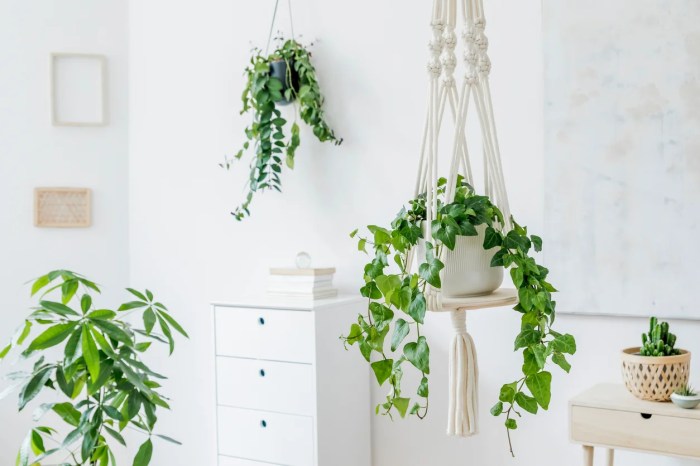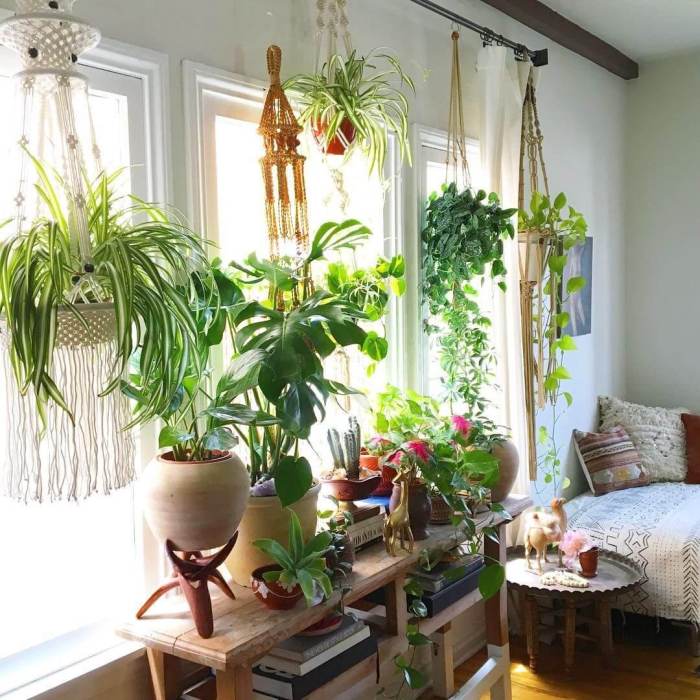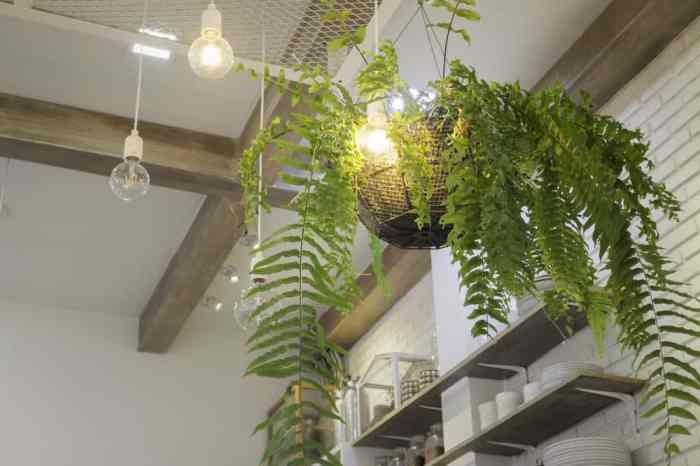Hanging plants from ceiling is a creative and visually appealing way to add life and style to your indoor and outdoor spaces. Whether you’re looking to create a lush indoor jungle or enhance the ambiance of your patio, hanging plants offer a versatile and charming solution.
In this comprehensive guide, we’ll explore the popular hanging plant options, provide a detailed care guide, demonstrate various ceiling mounting techniques, discuss aesthetic considerations, and share creative DIY hanging planter projects. Get ready to transform your space with the beauty and tranquility of hanging plants.
Popular Hanging Plant Options
Hanging plants are a popular choice for home decor, adding a touch of greenery and natural beauty to any space. They are also a great way to add life to small spaces or to create a vertical garden. There are many different types of hanging plants to choose from, each with its own unique look and benefits.
Some of the most popular hanging plants for indoor settings include:
- Spider plantsare known for their long, trailing stems and easy care. They are a good choice for beginners and can tolerate a wide range of light conditions.
- Pothosis another popular choice for indoor hanging plants. It is known for its heart-shaped leaves and trailing vines. Pothos is a low-maintenance plant that can tolerate low light conditions.
- Fernsare a classic choice for hanging plants. They come in a variety of shapes and sizes, and many ferns prefer the humidity that comes with being hung from the ceiling.
Some of the most popular hanging plants for outdoor settings include:
- Petuniasare a popular choice for outdoor hanging baskets. They come in a variety of colors and bloom profusely throughout the summer.
- Impatiensare another good choice for outdoor hanging baskets. They prefer shady areas and bloom in a variety of colors.
- Begoniasare a beautiful choice for hanging baskets. They come in a variety of colors and bloom all summer long.
When choosing a hanging plant, it is important to consider the amount of light the plant will receive, as well as the size and shape of the plant. It is also important to choose a plant that is appropriate for the climate in which you live.
Hanging Plant Care Guide

Hanging plants bring a touch of greenery and life to any room, but they require specific care to thrive. Understanding their unique needs ensures their beauty and longevity.
Hanging plants have specific lighting, watering, and fertilization requirements. Providing the right environment is essential for their well-being.
Lighting
Hanging plants vary in their light preferences. Some, like ferns and spider plants, prefer bright indirect light, while others, such as pothos and philodendrons, tolerate lower light conditions.
Hanging plants from the ceiling is a great way to add some greenery to your home. There are many different types of hanging plant baskets available, so you can find one that fits your style and needs. Hanging plant baskets from Bunnings are a great option if you’re looking for a budget-friendly option.
They come in a variety of sizes and styles, so you’re sure to find one that fits your needs.
Assess the light conditions in your space and choose plants that suit the available light. Avoid placing plants in direct sunlight, as it can scorch their leaves.
Watering, Hanging plants from ceiling
Hanging plants require consistent watering, but overwatering can lead to root rot. Allow the soil to dry out slightly between waterings, and water thoroughly until water drains from the drainage holes.
The frequency of watering depends on the type of plant, the size of the pot, and the humidity level in the room. Monitor your plants and adjust your watering schedule accordingly.
Fertilization
Hanging plants benefit from regular fertilization during the growing season (spring and summer). Use a balanced liquid fertilizer diluted to half strength and apply it every few weeks.
Fertilizing provides essential nutrients for plant growth and helps maintain their vibrant foliage.
Common Problems and Pests
Hanging plants are susceptible to common problems like pests and diseases. Here are some tips for addressing these issues:
- Pests:Aphids, mealybugs, and spider mites are common pests that can infest hanging plants. Treat infestations promptly with insecticidal soap or neem oil.
- Diseases:Fungal diseases like powdery mildew and root rot can affect hanging plants. Ensure proper drainage, avoid overwatering, and use fungicides as needed.
By providing the right care and addressing potential problems, you can ensure that your hanging plants thrive and bring beauty and life to your space.
Ceiling Mounting Techniques

Hanging plants from the ceiling adds a touch of greenery and life to any room. But before you start suspending your plants, it’s important to choose the right mounting technique to ensure they stay securely in place.
There are several methods for mounting hanging plants from the ceiling, each with its own advantages and disadvantages.
Hooks
Hooks are a simple and inexpensive way to hang plants from the ceiling. They can be screwed into the ceiling joists or rafters, or attached to a ceiling medallion. Hooks come in a variety of sizes and styles, so you can choose one that matches your décor.
However, hooks can only support a limited amount of weight, so they are not suitable for heavy plants. Additionally, hooks can be difficult to remove if you need to move your plant.
Brackets
Brackets are a more sturdy option for mounting hanging plants from the ceiling. They are typically made of metal or wood, and they can be attached to the ceiling joists or rafters with screws or bolts.
Brackets can support more weight than hooks, so they are a good choice for heavy plants. They are also easier to remove than hooks, so you can easily move your plant if needed.
Hanging plants from the ceiling can add a touch of greenery and freshness to any room. However, drilling holes into the ceiling is not always an option, especially in rented apartments or delicate surfaces. Fortunately, there are various methods for hanging plants without drilling holes, such as using hooks that attach to molding or adhesive strips . These methods allow you to enjoy the benefits of hanging plants without damaging your ceiling.
Ceiling Plates
Ceiling plates are a more decorative option for mounting hanging plants from the ceiling. They are typically made of metal or wood, and they can be attached to the ceiling joists or rafters with screws or bolts.
Ceiling plates can support a significant amount of weight, so they are a good choice for heavy plants. They are also easy to remove, so you can easily move your plant if needed.
Aesthetic Considerations

Hanging plants have become increasingly popular in interior design, offering a versatile and stylish way to enhance the visual appeal of any space. By suspending plants from the ceiling, homeowners and designers can create a sense of lushness and bring the outdoors in, adding life and color to any room.
Hanging plants offer a unique opportunity to add vertical interest to a space. By placing them at different heights, you can create a dynamic and visually appealing display. Hanging plants can also be used to draw attention to specific areas of a room, creating focal points and guiding the eye through the space.
Hanging plants from the ceiling can add a touch of greenery and life to any room. They are a great way to bring the outdoors in and can help to improve air quality. If you’re looking for hanging plants that will thrive in bright indirect light, there are many options to choose from.
Here are a few of our favorites . Once you’ve chosen your plants, you’ll need to decide how to hang them. There are a variety of ways to do this, so you can find a solution that works for your space and style.
Design Tips for Incorporating Hanging Plants
When incorporating hanging plants into your interior design, it’s important to consider the overall style of the room. For a modern or minimalist space, opt for simple and sleek hanging planters in neutral colors. For a more bohemian or eclectic style, choose planters with intricate patterns or bright colors.
The size of the hanging plants you choose should also be proportionate to the size of the room. In a small space, a few small hanging plants can add a touch of greenery without overwhelming the area. In a larger room, you can use larger hanging plants or group several smaller plants together to create a more dramatic effect.
Finally, consider the placement of your hanging plants. Avoid placing them too close to furniture or other objects, as this can create a cluttered look. Instead, hang them from the ceiling or from a shelf or bracket to create a more open and airy feel.
DIY Hanging Planter Projects: Hanging Plants From Ceiling
Unleash your creativity and personalize your home with unique hanging planters crafted from repurposed materials and innovative designs. Embark on a fulfilling DIY journey, transforming ordinary objects into extraordinary plant havens.
Macrame Magic
Harness the intricate art of macrame to weave mesmerizing plant hangers. With just a few knots, transform cords into bohemian-inspired masterpieces. Experiment with different knotting patterns and bead accents to create one-of-a-kind pieces.
Wooden Wonders
Embrace the warmth and durability of wood to craft rustic hanging planters. Repurpose old wooden boards, crates, or logs into charming plant holders. Add a touch of elegance with intricate carvings or a fresh coat of paint.
Recycled Revolution
Give new life to discarded items by transforming them into sustainable hanging planters. Utilize old tin cans, plastic bottles, or even broken ceramics to create whimsical and eco-friendly plant displays. The possibilities are endless!
Benefits of DIY Hanging Planter Projects
- Customization:Tailor designs to suit your personal style and plant needs.
- Cost-effective:Utilize repurposed materials to save money while creating unique pieces.
- Creative Expression:Unleash your inner artist and express your creativity through personalized designs.
Challenges to Consider
- Material Selection:Choose materials that are durable and suitable for outdoor or indoor use.
- Weight Capacity:Ensure that your planters can withstand the weight of the plant and soil.
- Hanging Mechanism:Select a secure and stable hanging method to prevent accidents.
Final Thoughts

Hanging plants from ceiling is a rewarding and creative way to enhance the aesthetics of your home. By following the care and mounting techniques Artikeld in this guide, you can enjoy the benefits of these beautiful plants for years to come.
Embrace the versatility of hanging plants and let them add a touch of nature and elegance to your living spaces.
Questions Often Asked
What are the most popular hanging plants?
Some of the most sought-after hanging plants include pothos, spider plants, philodendrons, ferns, and succulents.
How often should I water my hanging plants?
The watering frequency depends on the plant species, but a good rule of thumb is to water when the top inch of soil feels dry to the touch.
How can I mount hanging plants from the ceiling?
There are several methods for mounting hanging plants from the ceiling, including using hooks, brackets, or chains. The best method depends on the weight of the plant and the type of ceiling.